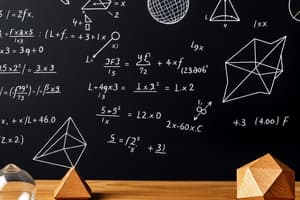Podcast
Questions and Answers
Which of the following branches of mathematics primarily deals with shapes and their properties?
Which of the following branches of mathematics primarily deals with shapes and their properties?
- Geometry (correct)
- Algebra
- Arithmetic
- Statistics
What is the correct order of operations according to PEMDAS?
What is the correct order of operations according to PEMDAS?
- Addition, Subtraction, Exponents, Multiplication, Division, Parentheses
- Exponents, Parentheses, Division, Addition, Multiplication, Subtraction
- Parentheses, Exponents, Multiplication and Division, Addition and Subtraction (correct)
- Multiplication, Parentheses, Addition, Division, Exponents, Subtraction
Which scientific method component involves making educated guesses to explain observations?
Which scientific method component involves making educated guesses to explain observations?
- Conclusion
- Hypothesis (correct)
- Observation
- Experimentation
In which historical period did feudalism and the rise of empires primarily occur?
In which historical period did feudalism and the rise of empires primarily occur?
Which literary device involves giving human traits to non-human entities?
Which literary device involves giving human traits to non-human entities?
What aspect of human geography studies the distribution and movement of populations?
What aspect of human geography studies the distribution and movement of populations?
Which of the following best describes the focus of biology in science?
Which of the following best describes the focus of biology in science?
Which of the following themes can often be found in literature?
Which of the following themes can often be found in literature?
Study Notes
Mathematics
-
Branches:
- Arithmetic: Basic operations (addition, subtraction, multiplication, division).
- Algebra: Solving equations, working with variables and expressions.
- Geometry: Properties of shapes, theorems (e.g., Pythagorean theorem), measurements.
- Calculus: Concepts of limits, derivatives, integrals, and their applications.
- Statistics: Data collection, analysis, probability, and interpretation.
-
Key Concepts:
- Order of Operations: PEMDAS (Parentheses, Exponents, Multiplication and Division, Addition and Subtraction).
- Functions: Definition, types (linear, quadratic), and graphs.
- Trigonometry: Relationships in triangles, sine, cosine, tangent.
Science
-
Branches:
- Biology: Study of living organisms, ecosystems, genetics, and evolution.
- Chemistry: Properties of matter, chemical reactions, periodic table.
- Physics: Laws of motion, energy, forces, waves, and electricity.
- Earth Science: Geology, meteorology, oceanography, and environmental science.
-
Key Concepts:
- Scientific Method: Observation, hypothesis, experimentation, conclusion.
- Cells: Basic unit of life, types (prokaryotic vs. eukaryotic).
- Laws of Thermodynamics: Energy conservation and transformation.
History
-
Periods:
- Prehistory: Stone Age, Bronze Age, early human societies.
- Ancient Civilizations: Mesopotamia, Egypt, Greece, Rome.
- Middle Ages: Feudalism, the rise of empires, the plague.
- Modern History: Industrial Revolution, World Wars, Cold War.
-
Key Concepts:
- Causes and Effects: Understanding historical events (e.g., the causes of WWI).
- Historical Analysis: Evaluating sources, perspective, bias.
- Major Figures: Contributions of leaders, philosophers, and activists.
Literature
-
Genres:
- Fiction: Novels, short stories, character development, and themes.
- Poetry: Structure (sonnets, free verse), literary devices (metaphor, simile).
- Drama: Elements of plays, character arcs, and dialogue.
-
Key Concepts:
- Literary Devices: Symbolism, irony, allegory, and motifs.
- Themes: Central ideas (love, conflict, identity) in literature.
- Historical Context: How the time period influences literary works.
Geography
-
Physical Geography:
- Landforms: Mountains, rivers, plains, plate tectonics.
- Climate: Factors influencing weather patterns and ecosystems.
-
Human Geography:
- Population: Demographics, migration patterns, urbanization.
- Culture: Language, religion, traditions, and their global interactions.
-
Key Concepts:
- Maps: Understanding scales, symbols, and types (topographic, political).
- Global Issues: Climate change, resource management, geopolitical conflicts.
Mathematics
-
Branches:
- Arithmetic: Engages with fundamental operations, including addition, subtraction, multiplication, and division.
- Algebra: Involves solving equations and manipulating variables and expressions to find unknowns.
- Geometry: Studies the properties and relationships of shapes, emphasizing theorems like the Pythagorean theorem.
- Calculus: Investigates limits, derivatives, and integrals, essential for understanding change and motion.
- Statistics: Focuses on data collection, analysis, interpretation, and the probability of events.
-
Key Concepts:
- Order of Operations: Remembers the sequence PEMDAS to solve mathematical expressions correctly.
- Functions: Defines a relation where each input has a unique output, encompassing different types like linear and quadratic functions.
- Trigonometry: Examines the relationships between the angles and sides of triangles, highlighting functions like sine, cosine, and tangent.
Science
-
Branches:
- Biology: Explores the characteristics of living organisms, their ecosystems, genetics, and evolutionary processes.
- Chemistry: Analyzes the properties of matter, the nature of chemical reactions, and organizes elements via the periodic table.
- Physics: Studies fundamental physical laws including motion, energy, forces, waves, and electricity.
- Earth Science: Covers geological formations, meteorological patterns, oceanographic phenomena, and environmental studies.
-
Key Concepts:
- Scientific Method: Outlines the process of scientific inquiry, encompassing observation, hypothesis formulation, experimentation, and conclusion.
- Cells: Identifies the cell as the fundamental unit of life, distinguishing between prokaryotic (without nucleus) and eukaryotic (with nucleus) cells.
- Laws of Thermodynamics: Emphasizes principles regarding energy conservation and transformation in physical processes.
History
-
Periods:
- Prehistory: Includes early human history focusing on the Stone Age, Bronze Age, and the development of primitive societies.
- Ancient Civilizations: Covers significant cultures such as Mesopotamia, Egypt, Greece, and Rome.
- Middle Ages: Characterized by feudal systems, empire expansions, and events like the plague.
- Modern History: Chronicles transformative events including the Industrial Revolution, World Wars, and the Cold War.
-
Key Concepts:
- Causes and Effects: Analyzes the relationships between historical events, such as the factors leading to World War I.
- Historical Analysis: Focuses on evaluating primary sources, assessing various perspectives, and recognizing bias.
- Major Figures: Highlights influential leaders, thinkers, and activists who shaped historical progress.
Literature
-
Genres:
- Fiction: Involves various narrative forms, emphasizing character development and thematic exploration in novels and short stories.
- Poetry: Examines structural elements like sonnets and free verse, utilizing literary devices such as metaphor and simile.
- Drama: Analyzes the components of plays, focusing on character arcs and the function of dialogue.
-
Key Concepts:
- Literary Devices: Identifies techniques like symbolism, irony, allegory, and motifs that enhance storytelling.
- Themes: Explores central ideas in literature, including love, conflict, and identity.
- Historical Context: Considers how the era influences literary creation and interpretation.
Geography
-
Physical Geography:
- Landforms: Studies natural features such as mountains, rivers, and plains, along with the impact of plate tectonics.
- Climate: Evaluates the elements that affect weather patterns and ecological systems globally.
-
Human Geography:
- Population: Investigates demographic trends, migration behaviors, and urbanization effects on communities.
- Culture: Examines the interplay of language, religion, and tradition within global dynamics.
-
Key Concepts:
- Maps: Understands the significance of scales, symbols, and different map types, including topographic and political maps.
- Global Issues: Addresses pressing concerns like climate change, resource sustainability, and geopolitical conflicts affecting humanity.
Studying That Suits You
Use AI to generate personalized quizzes and flashcards to suit your learning preferences.
Description
Test your knowledge of key concepts in mathematics and science. This quiz covers various branches including arithmetic, algebra, geometry, biology, chemistry, and physics. Challenge yourself with questions on fundamental principles and applications.




